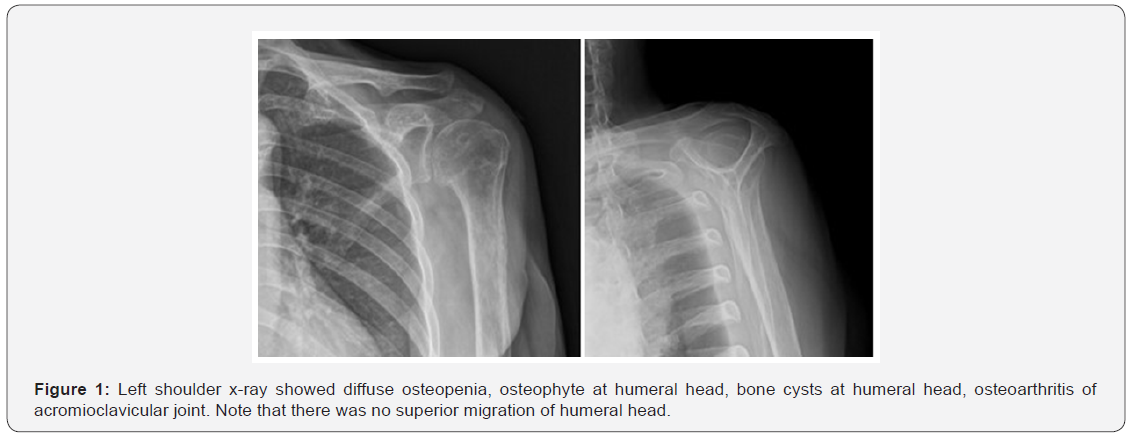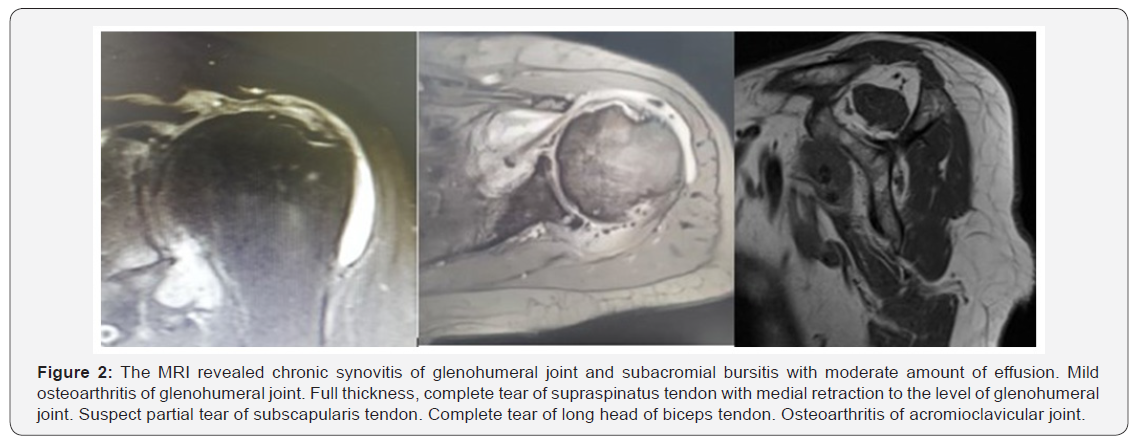Arthroscopic Synovectomy and Massive Rotator Cuff Repair in Patient with Rheumatoid Arthritis Shoulder
Pinkawas Kongmalai*
Department of Orthopaedics, Srinakarinwirot University, Thailand
Submission: January 24, 2018; Published: February 26, 2018
*Corresponding author: Pinkawas Kongmalai, Department of Orthopaedics, Faculty of Medicine, HRH Princess Maha Chakri Sirindhorn Medical Center, Srinakarinwirot University, 62 Moo 7 Nakhon Nayok 26120, Thailand, Tel: +66815703867; Email: pinkawass@hotmail.com
How to cite this article: Pinkawas Kongmalai. Arthroscopic Synovectomy and Massive Rotator Cuff Repair in Patient with Rheumatoid Arthritis Shoulder. Ortho & Rheum Open Access 2018; 10(5): 555796. DOI: 10.19080/OROAJ.2018.10.555796.
Abstract
There is no definite guideline concerning patient selection for operative intervention on rotator cuff tears in rheumatoid arthritis patients. This article presents a case of elderly patient with massive rotator cuff tear from rheumatoid arthritis. Physical examination and imaging showed that the supraspinatus and subscapularis tear were reparable. The arthroscopic synovectomy with supraspinatus and subscapularis repair were performed with excellent clinical outcome.
Introduction
Rheumatoid arthritis is a chronic inflammatory disease which characterized by an erosive, symmetrical polyarthritis that may lead to progressive disability [1]. Rheumatoid involvement of the shoulder is not only the destruction of the joint, but also associated with soft-tissue pathology which often involving the insertion of the rotator cuff. Rheumatoid arthritis patients are prone to tendon tears due to longstanding medical treatment of tissue toxic drugs such as cortisone and cell growth inhibitors. The quality of muscle and tendon is poor, the tissues are fragile, and many patients have pre-existing shoulder pathology [2,3]. In this case report, we describe an arthroscopic synovectomy with rotator cuff repair for massive rotator cuff tear including supraspinatus and subscapularis tendon.
Case Report
A 69-year-old right hand dominant female presented with left shoulder pain 6 months prior to admission. She had great difficulty raising her arm overhead as well as intense pain at night caused by sleeping. She sustained a minor fall from bicycle 10 months ago without significant disability. Her past medical history includes dyslipidemia and rheumatoid arthritis. Current medications are simvastatin, sulfasalazine, cyclophosphamide, methotrexate, chloroquine and folic acid. She denied alcohol drinking and tobacco use. The physical examination showed no obvious deformity or contusion. Mild tender at bicipital groove. Not tender at acromioclavicular joint. Active forward flexion was limited to 90 degrees and passive forward flexion is 160 degrees. Active arm abduction external rotation was 40 degrees, internal rotation is 30 degrees. Full passive arm abduction external rotation and internal rotation. There was positive Drop arm test, Jobe test, Lift off test, and Belly off test. The external rotation lag sign was negative. The strength test revealed 5/5 for external rotation and 2/5 for internal rotation. The x-ray of left shoulder showed mild osteoarthritis of glenohumeral joint. No superior migration of humeral head was seen (Figure 1). The MRI showed complete tear of supraspinatus with medial retraction to the level of glenohumeral joint. Suspect tear of subscapularis tendon (Figure 2).


An arthroscopic synovectomy and rotator cuff repair was performed. Severe synovitis was found in both glenohumeral joint and subacromial space. The long head of biceps was torn. A large crescent shape tear involving the anteroposterior dimension of the supraspinatus tendon was found. The upper 2/3 of articular side of subscapularis tendon was torn. After synovectomy was done, we repaired the supraspinatus tendon in double row suture-bridge technique with two suture anchors (Y-Knot® RC; Conmed) at the articular margin, and two suture anchors (PopLok® Knotless Suture Anchor; Conmed) laterally. Repair of subscapularis tendon was done with a suture anchor (Y-Knot® RC; Conmed) in Mac-stitch technique. Adequate fixation was noted for both supraspinatus and subscapularis tendon.
The patient’s upper extremity was immobilized in an abduction sling. At 6-week follow-up, the sling was discontinued and the physical therapy was started for passive range of motion exercise. The shoulder pain was completely resolved at this period. At 12-week-follow-up, the patient had full passive range of motion in all direction without pain. At 24 months after surgery, the patient demonstrated 170° of active forward flexion and abduction, external and internal rotation comparable to the contralateral side. The belly off test was negative. The author has obtained the patient’s written informed consent for print and electronic publication of the case report and accompanying images.
Discussion
The current information for rotator cuff tear in patients with rheumatoid arthritis is very little. When rotator cuff tear occurs in rheumatoid arthritis patients, they frequently have some degrees of degenerative changes of the shoulder joint. Some authors advocate against the surgical option of rotator cuff repair alone [4-6]. The non-surgical treatment can begin with activity modifications, medications, physical therapy or intra-articular steroid injection. If conservative treatment fails, surgery may be an option. It is crucial to understand the expectations of patients before choosing the surgical options. In addition, the patient should have goodwill to be compliant with the post-operative protocol. The mainstay of surgical management for rheumatoid arthritis shoulder has been synovectomy for early-stage and arthroplasty for late-stage disease [2,7,8] Smith and colleagues [9] report the series of rotator cuff repair in 23 shoulders with rheumatoid arthritis. In this population, they found that durable pain relief and patient satisfaction can be achieved. Interestingly, the functional gains could not be expected in patients with full-thickness rotator cuff tears. One should notice that only 5 patients of this series had a large to massive rotator cuff tear.
However, we thought that the general strategy for evaluation of reparability of the rotator cuff should not be difference from normal population. For massive rotator cuff tear, the decisive factors whether to repair the rotator cuff are the tendon retraction, the fatty infiltration and the upward migration of humeral head. For this patient, although the stump of the supraspinatus tendon was retracted nearly to the glenohumeral joint level, the degree of fatty infiltration is Goutalier grade 2 and there was no proximal migration. Therefore, we considered as the reparable rotator cuff tear.
According to Smith [1], arthroscopic synovectomy offers a reliable decrease in pain in rheumatoid arthritis shoulder. Recently, Lim SJ et al. [10] showed the contradict result. This study is the largest series of rotator cuff surgery in patients with rheumatoid arthritis with total number of 29 patients. There were ten large tears and seven massive tears. They found that the rotator cuff repair improved the shoulder functional outcome comparable to that in matched patients without rheumatoid arthritis. Our patient is in agreement with them. However, both of the above studies [9,10] did not mention the result of subgroup analysis outcome in a massive rotator cuff tear patients.
We did not perform the acromioplasty, because of the fear of sacrificing the coracoacromial ligament, thus compromising the coracoacromial arch, which will lead to more superior migration of humeral head. The acromioclavicular joint was also left untouched because the physical examination for acromioclavicular joint was negative. The Laine classification of rheumatoid arthritis of glenohumeral joint has 3 stages based on clinical and radiographic findings [3]. From clinical and x-ray findings, our patient was classified in stage 2. The reverse total shoulder arthroplasty would be better option if the patient has more severe arthritic change of the glenohumeral joint which refers to Laine classification stage 3.
Conclusion
In conclusion, when considering surgical options for massive rotator cuff tear in rheumatoid arthritis patient, the repair may be performed with good functional outcome if there is no sign of irreparable rotator cuff tear or severe arthritic change of the glenohumeral joint.
References
- Smith AM, Sperling JW, O’Driscoll SW, Cofield RH (2006) Arthroscopic shoulder synovectomy in patients with rheumatoid arthritis. Arthroscopy 22(1): 50-56.
- Curran JF, Ellman MH, Brown NL (1983) Rheumatologic aspects of painful conditions affecting the shoulder. Clin Orthop Relat Res 173: 27-37.
- Laine VAI, Vainio KJ, Pekanmäki K (1954) Shoulder Affections in Rheumatoid Arthritis. Ann Rheum Dis 13(2): 157-160.
- Chen AL, Joseph TN, Zuckerman JD (2003) Rheumatoid arthritis of the shoulder. J Am Acad Orthop Surg 11(1): 12-24.
- Hirooka A, Wakitani S, Yoneda M, Ochi T (1996) Shoulder destruction in rheumatoid arthritis. Classification and prognostic signs in 83 patients followed 5-23 years. Acta Orthop Scand 67(3): 258-263.
- Lehtinen JT, Belt EA, Lybäck CO, Kauppi MJ, Kaarela K, et al. (2000) Subacromial space in the rheumatoid shoulder: a radiographic 15-year follow-up study of 148 shoulders. J Shoulder Elbow Surg 9(3): 183- 187.
- Cruess RL (1980) Rheumatoid arthritis of the shoulder. Orthop Clin North Am 11(2): 333-342.
- Kieft GJ, Dijkmans BA, Bloem JL, Kroon HM (1990) Magnetic resonance imaging of the shoulder in patients with rheumatoid arthritis. Ann Rheum Dis 49(1): 7-11.
- Smith AM, Sperling JW, Cofield RH (2005) Rotator cuff repair in patients with rheumatoid arthritis. J Bone Joint Surg Am 87(8): 1782-1787.
- Lim SJ, Sun JH, Kekatpure AL, Chun J-M, Jeon IH (2017) Rotator cuff surgery in patients with rheumatoid arthritis: clinical outcome comparable to age, sex and tear size matched non-rheumatoid patients. Ann R Coll Surg Engl 99(7): 579-583.






























